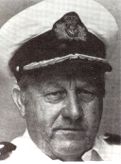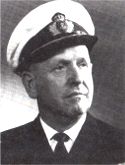|
You are here: 4Campaigns & Battles4Index4Kieler Expeditionary Force (1945) |
||||||||||||||||||||||||||||
|
Kieler Expeditionary Force (1945):
Personal initiative rescues
100 million kroner
|
|||||||||||||||||||||||||||
|
The initiative shown by an enterprising Lieutenant of the Naval Reserve, and active member of the Danish Resistance, quickly changed that. First Lieutenant Harry Larsen, who as CO of minesweeper MS 4 had played an important part in the scuttling of the Danish fleet at Holmen Naval Base on August 29, 1943, was at that time the district leader of the Resistance Movement in Faxe Ladeplads, a coastal area south of Copenhagen. When 260 Germans cadets and soldiers were taken prisoner here in the days after the capitulation, Harry Larsen decided to sail them direct to Northern Germany, in order to hand them over to the British Occupation Forces there. Larsen quickly borrowed 3,000 kroner from a local bank and chartered a small vessel, the KARLA, for the expedition. |
Harry Larsen, here seen as Commander s.g. |
On May 10 they reached Heilligenhafen near the German Island of Fehmern, where the captives were handed over into British custody.
In Heilligenhafen the Danes suddenly stumbled upon a series of ships that were unmistakably former Danish vessels.
They took possession of these, and the first expedition resulted in the recovery of a total of 10 vessels – though primarily former fishing boats that had been used by the Danes as auxiliary naval vessels ("P-cutters"), and a couple of customs cutters.
The success of the expedition gave Harry Larsen a taste for more, and after delivering the ships to Copenhagen, Larsen chartered the schooner HERDIS and borrowed some more money from the bank to meet the expenses of a new expedition.
Without the Danish Navy's approval
Following a request by the British, members of the Danish Resistance who had taken part in the first expedition were replaced by personnel from the Danish Navy.
|
Appointed second in command of the expedition was one of Harry Larsen's colleagues, First Lieutenant Ivar Westergaard, who had been so badly injured on August 29, 1943 by a German bullet that his right arm had had to be later amputated. In all, 21 men made up "Kieler Expeditionary Force", as they called themselves. However, Harry Larsen wasn't given proper authority for the planned operation, which turned out to be a problem when they reached Kiel. Here the British thought that the Danes were Nazi fugitives, and Harry Larsen had to return to Copenhagen accompanied by a British officer, where Vice Admiral Vedel confirmed his identity, before the British were satisfied. Vedel then approved the operation. |
First Lieutenant Ivar Westergaard, here seen as a Commander. |
In Kiel, the Danes were billeted in the former Dutch passenger ship ORANJE FONTEIN. From here, they toured around the many thousand ships and wrecks lying in the Kiel area in a motor boat, looking for Danish ships.
A car was also made available to Larsen, so he was able to visit other ports close by in Northern Germany.
However, the Danes were only able to search within the British zone, as the Russian Occupation authorities in the eastern section of Germany would not allow the Danes to search for ships in their area.
Minesweepers required
The Danes quickly found a number of Danish naval and commercial vessels, but their success gave rise to a new problem. The British demanded that the ships being taken be accompanied by a minimum of two minesweepers, before they could be permitted to leave Kiel.
The Danish Navy had no minesweepers available at the time for the task, and so a large collection of Danish ships quickly accumulated in Kiel – ships that couldn't make it back home to Denmark.
However, fortune smiled on the Danes.
During their searches in Kiel, they came across two vessels, which Larsen and Westergaard quickly recognized as the Danish minesweepers MS 3 and MS 5.
These vessels were followed to the nearby costal town of Laboe, but when the Danes boarded the vessels, the German crew initially denied that the vessels were Danish.
A quick visit to the engine room, where "Møller og Jochumsen, Horsens" was clearly legible on the main engine, quickly put the matter beyond doubt.
Three days later the ships were under Danish control, and after a much-needed internal and external wash, and an engine check, they were ready for use.
The shortage of minesweepers back in Denmark made Harry Larsen apprehensive that the top brass of the Danish Navy would take over the two minesweepers, if they were given the chance.
Therefore the minesweepers didn't berth at Holmen when they arrived in Copenhagen. Instead they entered a small civilian harbor, and didn't stay a moment longer than was strictly necessary before returning to Germany.
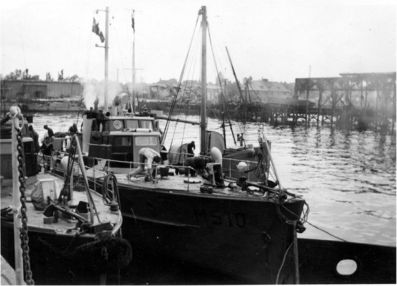
MS 3 and MS 5 photographed in the Tirpitzhafen the day after they were found in
Laboe, with a Danish "P-cutter" alongside, August 1945.
(from the private
collection of John Arentoft)
Unexpected visit
Whilst MS 3 and MS 5 were in the Tirpitzhafen they received an unexpected visit.
Alongside the two minesweepers lay the passenger ship MILWAUKEE, which served as the headquarters of the British authorities in the harbor area, and no less than Field Marshall Montgomery dropped in to visit the ship.
He was somewhat surprised to see two vessels flying the Danish flag at the stern, and asked the cadet on watch what on earth the Danes were doing in Kiel.
When he heard that they had come from Copenhagen, he commented "I was in Copenhagen yesterday". This would appear to be a somewhat bland description of the rapturous welcome parade through Copenhagen which that city's inhabitants afforded Montgomery and his British forces when they arrived in the city.
When Montgomery heard about the Danish mission, the Danish officers – two naval lieutenants and three cadets – were invited to attend a reception on board MILWAUKEE.
It was a fantastic experience for them to shake the hand of
"Denmark's
Liberator".
The X-ray valves
During the final stages of the war Harry Larsen had ended up in a firefight with Danish HIPO men (Hilfspolizei, Pro-Nazi Auxiliary police force), and had been injured in the foot. A hospital consultant, Dr Groth, from the Fakse Ladeplads Hospital had been summoned to remove a bullet from Larsen's foot – a bullet which Larsen since then always carried around in his wallet.
Shortly after the end of the war, Dr Groth came to Harry Larsen with a problem. The hospital's X-ray machine needed some valves, which were only manufactured in Hamburg.
At the end of the war all German production had been seized by the Allied Occupation Forces, and it was not possible to obtain new valves from within Denmark.
The doctor therefore asked Harry Larsen if he could accompany him to Kiel, in an attempt to lay his hands on the missing components from there. Larsen agreed, and Groth was issued with a cadet uniform and mustered into the ship’s crew.
To the considerable amusement of the ship's crew, it took some time before he got to grips with saluting, and initially he saluted everyone and everything.
Once in Kiel, Larsen acquired a vehicle and drove to Hamburg. As mentioned above, although all production had been seized by the British Occupation authorities, it proved possible to persuade the manager of the relevant factory to sell a consignment of valves to the Danes.
The following day, one of the cadets arrived at a prearranged location with a
truck borrowed for the purpose, and took delivery of the valves requested.
Back in Kiel, the valves – which were approx. 1 meter long and 40 cm in diameter
– were stowed on board the ships and taken back to the hospital in Fakse
Ladeplads.
The Danish ships were sailed back to Copenhagen. The only exceptions were the four DRAGEN and GLENTEN-class torpedo boats which following German pressure had been handed over to the German Navy in February 1941.[1]
Four of the boats were found in Flensburg. However, the torpedo boats had unfortunately been seriously damaged in a munitions explosion in Flensburg harbor – an explosion that had only occurred a few hours before the Danes arrived in the harbor.
The four vessels, which were still afloat after the explosion, were towed first to Sonderborg in Southern Denmark, and from there onward to Holmen at a later date.[2]
Just one accident
The expeditions only accident was when shipping company DFDS' ESBJERG was sunk by a mine near Stevns on 25 July 1945.
ESBJERG had been found with another DFDS ship, PARKESTON, in Lübeck in early July 1945. Since January 1944 both ships had served as target ships for German U-boats, but both were in good condition at the end of the war, and during the course of July DFDS had sent crews to Lübeck to sail the ships home.
The ships left Lübeck together with MS 3 on July 23, but already the next evening MS 3 developed engine trouble and had to be taken on tow by ESBJERG. The ships continued nonetheless toward Copenhagen, and at 2230 hours ESBJERG struck the mine a little south of Stevns.[3]
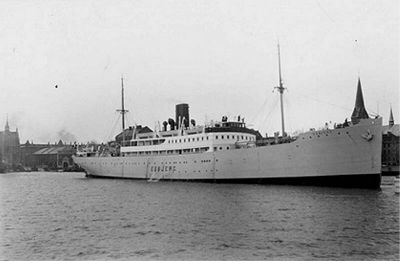
DFDS' Denmark-England ferry ESBJERG photographed before the war.
(Photo from the
collection of the Danish Maritime Museum).
The explosion severed the towing hawser between MS 3 and ESBJERG, and MS 3 immediately started to drift. With electric power onboard ESBJERG gone, the crew of MS 3 attempted to signal to PARKESTON that ESBJERG was sinking.
Unfortunately there were no signal lamps on board MS 3, so the rather unorthodox method of holding a mattress up against the wheelhouse was decided upon. A somewhat interim solution, but it worked and PARKESTON received the signal that ESBJERG was in distress.
PARKESTON reached the sinking ESBJERG by dawn, from which all the crew, with the exception of the captain, the first mate and a helmsman, had already taken to the boats.
Nonetheless, a few more hours passed before ESBJERG keeled over and sank noisily beneath the waves. By then, however, the three remaining crew had already safely left the ship.[4]
100 million kroner
Kieler Expeditionary Force recovered a total of 37 vessels.
From the Danish Navy there were the three minesweepers MS 3, MS 5 and HAJEN, plus a total of ten "P-cutters".
In addition, they found the survey ship FREJA in useable condition together with the wreck of the inspection ship INGOLF, which had been sunk by Allied aircraft in the last months of the war.
Of the smaller vessels, the two training vessels SVANEN and THYRA were found in Kiel, together with the pilot cutter SKAGERRAK. Finally, the bombed-out wreck of Dampbåd A was found near Flensburg.
They were not successful in locating the torpedo recovery vessel SLEIPNER, but the Danes took an equivalent German vessel instead, which was sailed back to Denmark and there renamed SLEIPNER.
In November 1945 the minesweeper SØHESTEN, which had been found in Brunsbüttel, became the last ship to be recovered.
.jpg)
The minesweeper SØHESTEN, seen here around 1956, was the last ship recovered by
Kieler Expeditionary Force.
(Photo: Royal Danish Navy/from Gunnar Olsen's archive)
In addition, 16 large commercial vessels were found, of which twelve were in a good enough condition to be sailed back to Denmark.
The total expenses amounted to 23,000 kroner. A large disbursement, but subsequent calculations put a combined value of approx 100 million kroner on all the ships, so there is no doubt that the expedition recovered its own costs!
The Danish Resistance Movement later repaid the loans which Harry Larsen had taken out in order to cover the expenses of the trip.
The shipping company DFDS, to which most of the recovered cargo and passenger vessels belonged, subsequently expressed their gratitude by paying a reward of 2,500 kroner to Harry Larsen.
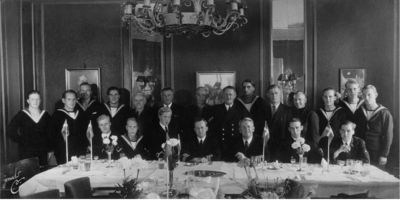
Farewell dinner for the members of Kieler Expeditionary Force at
"Esplanaden"
restaurant on August 15, 1945, after completing their mission.
Seated in the middle are Harry Larsen (left) and Ivar Westergaard (right).
(From the private collection of John Arentoft)
Notes:
[1] For a detailed account of the seizure of the torpedo boats in 1941, see Marinehistorisk Tidsskrift #4 / 2002.
[2] The munitions explosion in Flensburg and the destruction of the Danish torpedo boats are described in detail in Marinehistorisk Tidsskrift #XX.
[3] At position 55? 14’ 43” N and 12? 40’ 72” E
[4] In August 1946 Esbjerg was raised and subsequently sold to a Spanish company, which operated the ship until 1978 under the name Ciudad de Ibiza.
Sources:
The author wishes to thank Otto Ludwig and John Arentoft, both of whom made their personal accounts and pictures available, and who have reviewed and commented on the text.
After the expedition, Harry Larsen submitted a lengthy report to the Danish Navy Staff, but despite extensive efforts it had not been possible to locate the report in the Danish Navy archives.
Translated by Alan Russel
![]()
- Do you miss a major event on this Site,
or do you hold a great story?
Are you able to contribute to the unfolding of
the Danish Naval History,
please
e-mail
me, enclosures are welcome.
Please remember to list your sources.
You can also use the Naval Web Forum on this web-site.
![]()
|
MORE IN-DEPTH STORIES FROM |
|
The Explosion in Flensburg (1945) - Kieler Expeditionary Force (1945) - JUTLANDIA in Korea - Somebody just had to do it - NARHVALEN reported missing in the Skagerrak (1970) - The Battle off Gedser (1980) - Missile Incident at Lumsaas (1982) |
|
THE TOPIC STORIES: |
|
- Wars against England (1801-1814) - Reconstructing the Navy (1814-1848) - The 1st Schleswig War (1848-50) - The interim War Years (1850-64) - The 2nd Schleswig War (1864) - The long Period of Peace (1864-1914) - The Navy during the 1st World War (1914-1918) - The Interim Years (1919-1939) - The Navy during the 2nd World War (1939-1945) - The Cold War Period (1945-1989) - |
|
SEE ALSO: |
-
-
This page was last updated: -
This page was first published: February 10, 2008
Copyright © 2013-2016 Johnny E. Balsved - All rights reserved - Privacy Policy

